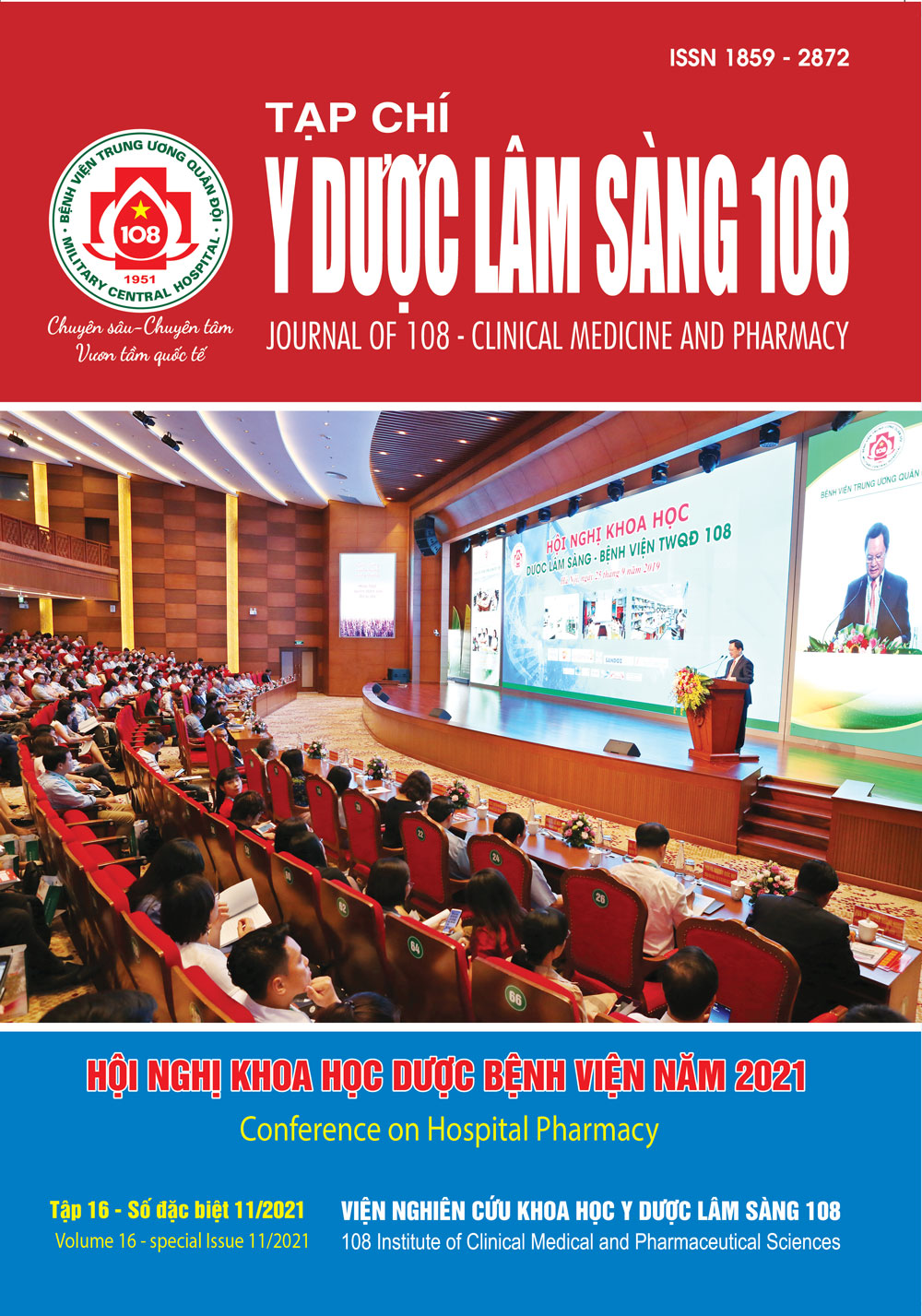Nghiên cứu điều chế dược chất phóng xạ 18F-FLT cho ghi hình PET/CT
Main Article Content
Keywords
Tóm tắt
Mục tiêu: Đánh giá khả năng sản xuất 18F-FLT và ghi hình 18F-FLT PET/CT tại Việt Nam. Đối tượng và phương pháp: Dược chất phóng xạ 18F-FLT được điều chế trên module tự phát triển của nhóm nghiên cứu Bệnh viện Trung ương Quân đội 108, chất lượng theo Ph.Eur. 14 và định tính ghi hình 18F-FLT PET so sánh với 18F-FDG PET trên chuột nhắt BALB/c gây u phổi thứ phát dòng LLC. Kết quả: Khi thay đổi thời gian bắn bia từ 10 phút đến 120 phút sản lượng 18F-FLT dao động từ 57 ± 4 đến 184 ± 14mCi/mẻ, hiệu suất tổng hợp (EOS) dao động từ 9,6 ± 1,3 đến 27,6 ± 2,1%, tuy nhiên với thời gian bắn bia là 20 phút cho sản lượng và hiệu suất tổng hợp là cao nhất. Thuốc đạt yêu cầu theo EurPh 14. Chụp 18F-FLT PET/ CT và 18F-FDG PET/CT cho thấy cả 2 DCPX đều tăng hấp thu vào khối u. Sự khác biệt là 18F-FDG tăng hấp thu ở não còn 18F-FLT không hấp thu vào não do 18F-FLT hầu như không đi qua hang rào máu não. Kết luận: Điều chế dược chất phóng xạ 18F-FLT cho ghi hình PET/CT hoàn toàn có thể thực hiện được ở Việt Nam.
Article Details
Các tài liệu tham khảo
2. Berman DS, Hachamovitch R, Kiat H, Cohen I, Cabico JA, Wang FP, Friedman JD, Germano G, Van Train K, and Diamond GA (1995) Incremental value of prognostic testing in patients with known or suspected ischemic heart disease: Abasis for optimal utilization of exercise technetium-99msestamibi myocardial perfusionsingle-photon emission computed tomography. Journal of the American College of Cardiology 26(3): 639-647.
3. Kostakoglu L, Agress H and Goldsmith SJ (2003) Clinical Role of FDG PET in evaluation of cancer patients. Radiographics 23: 315-340.
4. Lee Y (2010) Radiopharmaceuticals for Molecular Imaging. The Open NuclearMedicineJournal 2: 178-185.
5. Grierson JR and Shields AF (2000) Radiosynthesis of 3’-Deoxy-3'-[(18)F]Fluorothymidine: [(18)F]FLT for imaging of cellular proliferation in vivo. NuclearMedicine and Biology 27: 143-156.
6. Been LB, Suurmeijer AJ, Cobben DC, Jager PL, Hoekstra HJ and Elsinga PH (2004) [18F]FLT-PET in incology: Current status and opportunities. European Journal of Nuclear Medicine and Molecular Imaging 31: 1659-1672.
7. Fuchs K et al (2013) In vivo imaging of cell proliferation enables the detection of theextent of experimental rheumatoid arthritis by 3’-Deoxy-3’-18F-Fluorothymidine and small-animal PET. Journal of Nuclear Medicine 54: 151-158.
8. Wilson IK, Chatterjee S and Wolf W (1991) Synthesis of 3’-Fluoro-3’-Deoxythymidineand studies of Its 18F-radiolabeling, as a tracer for the non-Invasive monitoring of the biodistribution of drugs against AIDS. Journal of Fluorine Chemistry 55: 283-289.
9. Nguyễn Khắc Thất, Nguyễn Thị Kim Dung, Mai Hồng Sơn, Lê Ngọc Hà (2021) Đánh giá hình ảnh phân bố dược chất phóng xạ 18F-fluorine fluorothymidine PET trên động vật thực nghiệm. Tạp chí Y Dược học số 25 - Tháng 07/2021, tr. 46-50.
10. Bùi Thanh Rin, Nguyễn Khắc Thất, Trần Văn Diện, Trương Thành Đạt, Nguyễn Đức Trung, Nguyễn Văn dinh, Phạm Tuấn Linh (2021) Nghiên cứu điều chế dược chất phóng xạ 18F-fluorothymidine trên module tự động được phát triển trong nước. Tạp chí Y Dược học số 25 - Tháng 7/2021, tr. 117-122.
11. ICH (2013) The international conference on harmonisation of technical requirements for registration of pharmaceuticals for human use.
12. Strickley RG (2004) Solubilizing excipients in oral and injectable formulations. Pharmaceutical Research 21: 201-230.
13. Scott PJH and Hockley BG (2012) Radiochemical syntheses, volume 1: Radiopharmaceuticals for positron emission tomography. John Wiley and Sons, Hoboken.
14. Serdons K, Verbruggen A and Bormans G (2008) The presence of ethanol inradiopharmaceutical injections. Journal of Nuclear Medicine 49: 2071.
15. Patrice M, Ali O, Michel P, Jacky S, Patrice
L, Fr´ed´eric Boisson, David B (2016) Automated and efficient radiosynthesis of [18F]FLT using a low amount of precursor. Nuclear Medicine and Biology
doi: 10.1016/j.nucmedbio.2016.05.009.
16. Leonardo Tafas C. Nascimento, Juliana B Silva, Marina B Silveira, Priscilla F Santos, and Tiago Faria (2013) Synthesis and quality control of [F]fluorothymidine. 2013 International Nuclear Atlantic Conference - INAC 2013, Recife, PE, Brazil: 24-29.
17. Leonardo TCN, Marina BS, Soraya MZMD Ferreira, Juliana BS ( ) Comparison between two ethanolic solutions for 3’-Deoxy-3’-[18F]Fluorothymidine elution.
18. Herholz K, Rudolf J & Heiss WD (1992) FDG transport and phosphorylation in human gliomas measured with dynamic PET. Journal of Neuro-Oncology 12: 159-165.
19. Shields AF et al (1998) Carbon-11-thymidine and FDG to measure therapy response. Journal of Nuclear Medicine 39(10): 1757-1762.
20. Kong XB et al (1992) Comparisons of anti-human immunodeficiency virus activities, cellular transport, and plasma and intracellular pharmacokinetics of 3’-fluoro-3’- deoxythymidine and 3’-azido-3’-deoxythymidine. Antimicrob Agents Chemotherapy 36: 808-818.
 ISSN: 1859 - 2872
ISSN: 1859 - 2872
